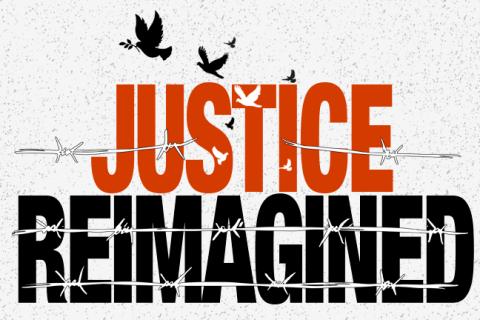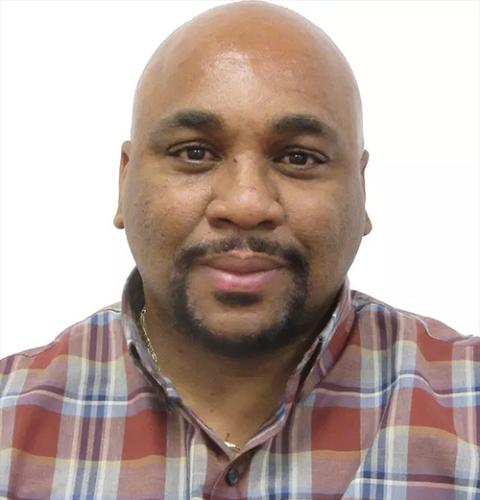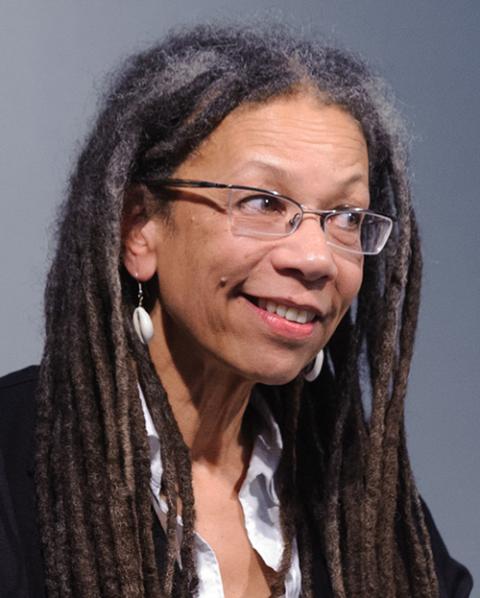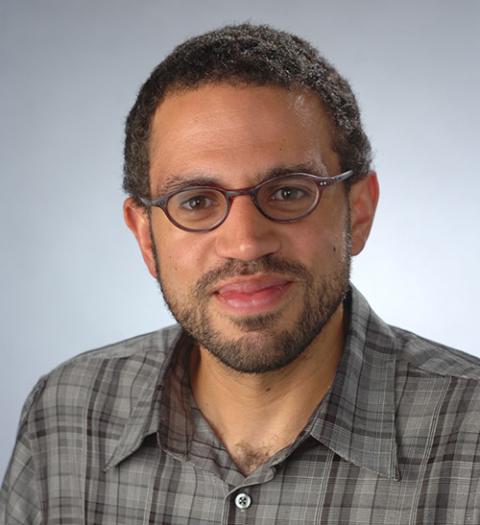
A call for abolition is seen in Santa Cruz, California, during a 2013 demonstration against prison overcrowding in the state. (Flickr/Richard Masoner)

Editor's note: A year ago, after the murder of George Floyd, the U.S. exploded with protests bringing attention to the scourge of police violence against African Americans. Initial calls to "defund the police" have since been nuanced to call for substantive reform that includes reappropriation of funds for other social services. But policing is just part of a massive justice system that includes courts, jails and prisons. In this four-day series, "Justice Reimagined," two NCR writers look at the prison abolition and reform movements, as well as what might work better: restorative justice. The three stories on prison abolition/reform are by Bertelsen fellow Madeleine Davison; former NCR executive editor Tom Roberts reported the two pieces on restorative justice.
Read the first story in the series:
Kazembe Balagun first got a glimpse of abolition when he visited southern Mexico in the 1990s to stand in solidarity with farmers aligned with the Zapatista movement.
A man in the town where Balagun stayed had been caught stealing a chicken from a neighbor — a serious offense in a community of subsistence farmers.
After some discussion, the community's elders asked the man to repay the amount he had cost his neighbor. They also convened a meeting with the man to discuss the life circumstances that led him to steal the chicken.
"It was the first time I saw restorative justice in action," Balagun said. "It shocked me because I'm coming from Harlem, where when someone steals something ... you call the police. The police arrest [them]. And then that's it. You never hear from the person again."
Balagun, an activist who has been involved in a wide variety of Black liberation and anti-capitalist campaigns over the past several decades, said his Christian faith and his lived experiences have led him to work toward abolishing prisons, policing and punitive responses to harm.
Christians are called to follow the example of Jesus, who was killed by an imperial state, and spent his life caring for those on the margins, Balagun said.
"The abolitionist movement focuses on that and says a different society is possible, that we can confront all the social ills that are happening right now with compassion and abundance," he said.
Prison abolition is not a new concept, but in the past decade, the movement, led by Black scholars and activists as well as incarcerated people, has gained new traction in mainstream media as Black Lives Matter and other movements against systemic racism have galvanized the nation.
In 2020, massive anti-racism uprisings following the police killing of George Floyd motivated millions of people to re-examine the role of the police and the prison-industrial complex more broadly, activists told NCR.
Abolition versus reform
Vandrick Towns, a formerly incarcerated man who now works as a program manager at Options Recovery Services, said he is not fully on board with abolishing prisons, but he believes in drastically reducing the prison population, preventing violence and building alternatives to incarceration.
Towns said about 5% of the people he met in prison are there for a good reason. And he doesn't think prisons are ever likely to be abolished.
"The prison [system] needs to be revamped; it needs to be torn down to the bare bones and rebuilt with a restorative justice approach," Towns said.
Others believe prisons need to be abolished entirely.

Demonstrators in the District of Columbia stage a motorized protest outside the Correctional Treatment Facility against sanitary conditions inside prisons April 25, 2020. (CNS/Reuters/Tom Brenner)
Abolitionists have varied purposes and strategies, but those who spoke to NCR outlined a few common goals:
- Defunding and abolishing police, prisons and other forms of correctional control;
- Ending oppressive systems like racism, patriarchy and economic inequality;
- Investing in necessities and services that help people thrive;
- Building new, restorative and transformative methods of addressing harm and violence.
Prison reform is based on the idea that the system is broken and can be fixed, said Micah Herskind, a Christian abolition advocate who works for the Southern Center for Human Rights.
"What abolitionists say is that actually the system is not broken," Herskind said. "The system emerged out of slavery and slave patrols and segregation and the long arc of many different forms of racial and class control. And it's actually working incredibly efficiently in order to achieve the goals of maintaining social inequality."
If, as abolitionists believe, the system is working as planned to prop up racism and oppression, then it can't just be reformed — it needs to be abolished and replaced with something else, Herskind said.
Prisons do not solve the problems they are said to solve, said Dwayne David Paul, a Catholic educator and writer who works for the Collaborative Center for Justice but spoke to NCR in his capacity as a private individual.
Paul, who favors abolition, said incarcerating people for using drugs doesn't solve the larger systemic problems — such as widespread unemployment or economic distress — that lead many people to become addicted in the first place.
Instead of providing high-quality resources for survivors of domestic violence, Paul said, we spend taxpayer money incarcerating survivors — some for fighting back against their abusers.
Incarceration has, at best, a minimal effect on violence, and increased incarceration rates do not improve public safety, according to the Vera Institute.
Although he isn't an abolitionist, Towns said prison didn't solve any of the problems that he had when he went in.

Vandrick Towns (Courtesy of Our Road Prison Project)
Towns grew up in a community that had been economically deprived. His parents had to work two or three jobs just to make ends meet. When he was a teenager, he was shot and injured by a member of a local gang. His dreams of playing football were shattered.
Towns said in his neighborhood, there weren't many mental health care resources or therapists for Black and brown people. Towns used to hate gangs because of what they did to his community, he said, but he joined one after he was shot because it gave him a sense of belonging and protection that he longed for.
"I needed therapy. ... I needed to learn how to regulate my emotions. I needed to learn how to process that grief and loss of losing my dream," he said.
Instead, he got life in prison, with the possibility of parole only after 17 years.
Reforms such as building more prisons to reduce overcrowding, or putting people on electronic monitoring instead of in prison tend to increase the number of people in prison or under correctional supervision, according to journalists Victoria Law and Maya Schenwar. Law and Schenwar wrote the book Prison by Any Other Name, which examines the results of popular prison reforms over the years.
Even drastic reforms — ending cash bail, releasing all Black people, and releasing all people incarcerated for drug-related and nonviolent crimes — would only cut the prison population roughly in half, said Vincent Lloyd, director of Africana Studies at Villanova University and co-author with Joshua Dubler of Break Every Yoke: Religion, Justice, and the Abolition of Prisons.

Ruth Wilson Gilmore (Flickr/Heinrich-Böll-Stiftung/Stephan Röhl)
Abolitionists such as Ruth Wilson Gilmore — a professor of geography at the City University of New York — advocate for changes that "take away power, resources, authority, legitimacy from the system" and place those resources into "life-giving institutions" that provide things people need, like food, housing and education, Herskind said.
"The only way to actually end mass incarceration is to transform the way we're thinking about the prison from a necessary institution, to an institution that has to be eliminated," Lloyd said. "Abolition provides a kind of horizon for political engagement. The goal is a world without prisons, and that guides the practical steps to take today."
Adding, not just subtracting
One example of abolitionist policy is the #8toabolition campaign, launched in the summer of 2020.
The campaign includes steps to defund police and reallocate that money toward other services, remove cops from schools, free people from jails and prisons, and fund housing and other necessities. The goal of #8toabolition is not to create a better police and prison system, but to build a society without police and prison, where communities have what they need to thrive without these institutions.
Gilmore has written that prison abolition is the "presence ... of life-affirming institutions," rather than just the absence of prison buildings.
In a talk hosted by the publisher Haymarket Books, Gilmore added, "Abolition is about abolishing the conditions under which prison became the solution to problems."
Dean Dettloff, a lecturer at the Institute for Christian Studies in Toronto, emphasized that abolition isn't just about a lack of something. Citing Gilmore, he wrote in an email to NCR that abolition is "about trying to build a concrete, healthy society that meets people's material, psychological, and spiritual needs."
Our current society doesn't do that, he wrote. Instead, it preys on people who are made vulnerable by racial capitalism.
"We need to replace that society with real alternatives, which means the presence of new support systems, public health care, more labor unions, a just distribution of wealth, and so on," Dettloff wrote.
Syrita Steib, executive director of Operation Restoration, which serves currently and formerly incarcerated women, told NCR the way the U.S. handles harm is not working. Addressing people's needs, rather than punishing people, would help prevent violence, she said.

Syrita Steib (NCR screenshot/YouTube/Global Georgetown)
"[What] if we address the lack of education, we address the lack of safe and secure housing, or food insecurity, or access to good medical treatment?" said Steib, who is formerly incarcerated. "If we actually take time to address those things, what would the differences be for people in the community and how would that have an impact on incarceration?"
Steib told NCR that she herself is a survivor of violence — she was physically abused as a child and sexually assaulted at age 16. Her sister* was murdered the week before she was released from prison.
But in a panel hosted in February by Georgetown University, Steib said she doesn't necessarily believe those who abused her should be thrown in prison. Violence is learned, she said.
"You would think I'd be like, 'Yes, they have to be punished,' " she told the panel audience in February. "But the thing that I've learned in this work is that hurt people hurt people."
In an interview with NCR, Steib added that victims and survivors don't always want revenge for what was done to them.
"Systems of exacting revenge ... [are] not even based on the victim," Steib said. "It's based on what people think the victim wants or what we think is best for the victim."
Furthermore, she said the lines between victims and abusers aren't always clear. Like her, the vast majority of incarcerated women are survivors of sexual or physical abuse, according to the Vera Institute of Justice.
Advertisement
Steib said although she comes from an abolitionist perspective, she has difficulty reckoning with what to do about people who sexually abuse children, for instance. But at the same time, she has learned that many of those who abuse children were abused themselves at some point.
People are fully responsible for their behavior as adults, she said. At the same time, many of those who commit violence were "failed" by society when they were young.
Steib said addressing the underlying causes of violence is more effective than punishment.
"We have this fascination with incarceration ... like the only way to teach someone their lesson is to put them through the worst possible time of their life and treat them as inhumanely as possible and have an expectation that there's going to be this awesome result," she told NCR.
Placing people who have harmed others in situations where they are likely to endure harm themselves seems counterproductive, Lloyd said. In 2015, incarcerated people filed more than 24,000 allegations of rape and sexual abuse, both by guards and other incarcerated people, according to the Marshall Project.

Vincent Lloyd (Courtesy of Villanova University)
"It's hard to figure out how that's supposed to result in them coming out of prison, and then not causing more harm," Lloyd said. "If you put a bunch of people who've caused harm together and break their connections with their families and communities and support systems that could orient them towards the good."
Furthermore, not all kinds of violence are criminalized, Herskind said. He said the fact that no one has been criminalized for complicity in preventable COVID-19 deaths shows that "crime" accounts for only a small part of the violence people inflict on each other.
Combatting systems that harm people — including white supremacy and patriarchy — is just as important as preventing interpersonal violence, he said.
Transformative justice
Prison abolition requires creativity and imagination, activists and scholars told NCR.
The Rev. Nikia Smith Robert, author of "Penitence, Plantation and the Penitentiary: A Liberation Theology for Lockdown America" and founder of Abolitionist Sanctuary, said she envisions a world without prisons as one in which funds are redistributed away from prisons toward institutions and infrastructure that give people just and equitable access to resources they need to thrive.
"Our budget should reflect our values, right?" Smith Robert said. "If our budgets are supporting our prison proliferation, then our values are aligned with retribution, and punishment and violence. But if our budget supports building equitable schools, then our values are aligned with equality. And those are the democratic ideals that will make this country flourish."
Justice should "repair, restore and rebuild individuals and communities for flourishing," Smith Robert said.

Black Lives Matter demonstrators are seen near Lafayette Square in Washington Aug. 12, 2018. Prison and police abolitionists often argue that money spent on these institutions could be better spent on housing, education, health care and other services people need to thrive. (CNS/Tyler Orsburn)
"People who are victims of violence should not in any way still carry the harm, and [should] feel that in some way they were repaired and restored," Smith Robert said. "Likewise, the person who has participated in whatever infringement shouldn't benefit from their harm. There should be accountability."
But harm is rarely straightforward, and neither is transformative justice, a practice of justice that addresses harm with communal values that center healing and accountability without retributive practices that rely on the police or the state. It shares many commonalities with restorative justice, but differs in that transformative justice also attempts to right systemic wrongs that may have created the conditions for the individual act to occur and shifts the narrative from individual blame.
For instance, Smith Robert said, if a Black mother commits fraud to get her child into a different school district with better resources, instead of going to prison, she could be asked to repay whatever money she cost the school district that her child was fraudulently attending.
But at the same time, transformative justice would require looking at why her child's neighborhood school had less funding than other schools, and correcting the structural problems — including racial and class oppression — that caused the disparity in the first place. It would mean creating a more equitable education system.
Transformative justice is "more of rebuilding, [and] imagining something new … And that also means revisiting our practice," Smith Robert said. "So that in this new system that we build, punishment is no longer a practice."
*This story has been updated to reflect that Syrita Steib's sister was murdered. NCR regrets the error.






